The 1990 Volvo 240, a stalwart of the Swedish automaker’s lineup, embodies a bygone era of automotive design and engineering. This boxy brick, affectionately nicknamed the “brick,” was a testament to Volvo’s commitment to safety and durability, qualities that propelled it to global acclaim.
The 240 was more than just a car; it was a symbol of practicality, reliability, and a touch of Scandinavian elegance.
Introduced in 1974, the 240 series, which included the 242, 244, and 245 models, became a mainstay for Volvo. The 1990 model year, marking the final year of production, saw a culmination of refinements and updates that solidified its place as a legend.
Its enduring popularity stems from its rugged build, spacious interior, and a legacy of safety innovations that set the benchmark for the industry.
Introduction to the 1990 Volvo 240
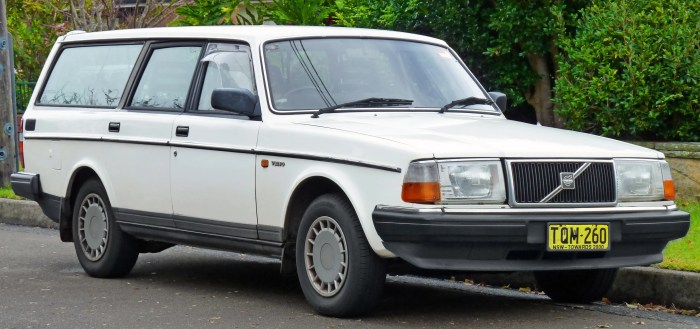
The 1990 Volvo 240, a classic car known for its robust build and timeless design, marked the end of an era for the Swedish automaker. It was the final year of production for the 240 series, which had been in production for a remarkable 19 years.
This extended lifespan, coupled with its reputation for safety and reliability, cemented the 240’s place as an icon in automotive history. The 1990 Volvo 240 embodied the brand’s core values of safety and durability. It was built on a robust platform, featuring a boxy design that prioritized passenger protection.
This commitment to safety was evident in its extensive use of steel, including a rigid passenger cell, and the inclusion of features like anti-lock brakes and crumple zones, which were ahead of their time.
The Target Audience and Market Position of the 1990 Volvo 240
The 1990 Volvo 240 appealed to a diverse audience seeking a reliable, safe, and practical vehicle. It was particularly popular among families, professionals, and those who valued longevity and durability. The 240’s reputation for safety attracted parents seeking a vehicle to protect their families, while its practicality and durability appealed to professionals who needed a vehicle that could handle the demands of daily commutes and long-distance trips.
Performance and Handling: 1990 Volvo 240
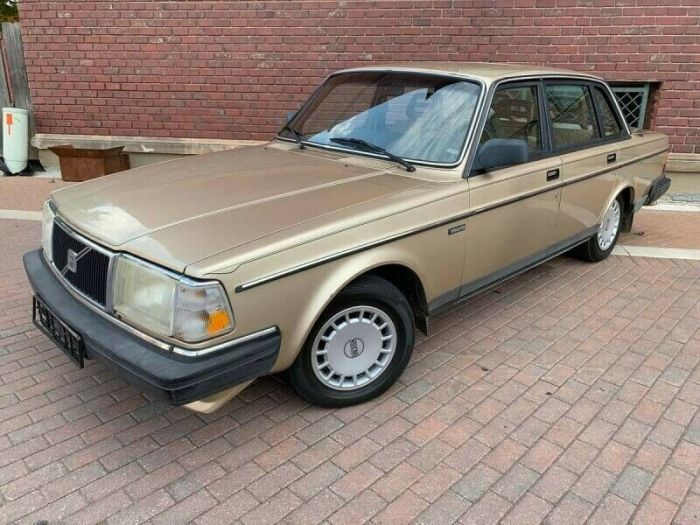
The 1990 Volvo 240 was known for its robust build quality and reliability, but its performance wasn’t considered particularly exciting. While it wasn’t a sports car, it offered a comfortable and practical driving experience.
Engine Specifications and Power Output
The 1990 Volvo 240 was available with a range of four-cylinder engines, including the 2.3-liter B230F and the turbocharged 2.3-liter B230FT. The naturally aspirated B230F produced 116 horsepower, while the turbocharged B230FT offered 158 horsepower. Both engines were known for their durability and reliability, but the turbocharged engine provided a noticeable boost in performance.
Driving Experience
The 1990 Volvo 240’s driving experience was characterized by its smooth and comfortable ride. The car’s suspension was tuned for a comfortable ride, and the steering was precise and responsive. The acceleration was adequate for daily driving, but the car was not particularly quick.
The braking performance was reliable, but the car’s weight could sometimes lead to longer stopping distances.
Comparison to Competitors
In the late 1980s and early 1990s, the Volvo 240 competed with other mid-size sedans like the BMW 3 Series, the Mercedes-Benz 190E, and the Audi 80. While the Volvo 240 offered a comfortable and reliable driving experience, its performance was not as impressive as its competitors.
The BMW 3 Series and Mercedes-Benz 190E were known for their handling and performance, while the Audi 80 offered a more refined and luxurious driving experience.
Interior and Comfort
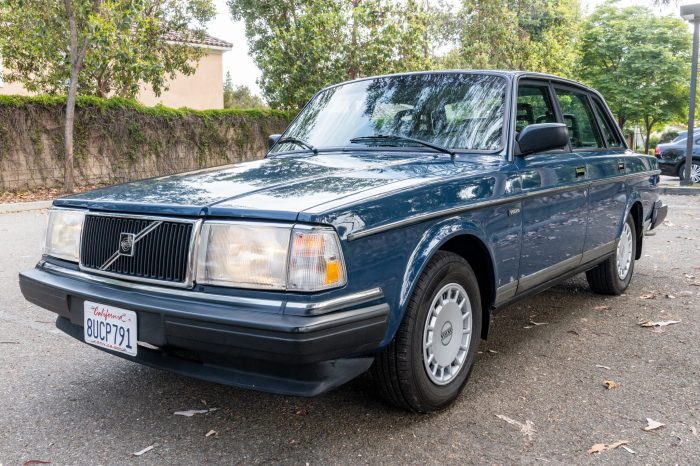
The 1990 Volvo 240’s interior is a testament to Scandinavian design principles, prioritizing functionality and durability over flashy aesthetics. While it may not boast the opulent materials found in luxury cars of the era, the 240’s cabin is designed for practicality and comfort, offering a spacious and uncluttered environment.
Interior Design and Materials, 1990 Volvo 240
The 1990 Volvo 240’s interior is characterized by its simplicity and practicality. The dashboard is straightforward and easy to use, with large, clear gauges and controls. The materials are durable and long-lasting, with vinyl and fabric upholstery that is both comfortable and easy to clean.
The 1990 Volvo 240, known for its durability and boxy design, shared a lineage with the iconic Volvo 1800 series, which introduced the world to the Swedish automaker’s distinctive style. The 1973 Volvo 1800ES , with its sporty fastback profile, represented a departure from the traditional Volvo sedan, showcasing a more dynamic and luxurious approach.
This influence can be seen in the later 240, which offered a blend of practicality and a hint of sporty elegance, making it a popular choice for both families and enthusiasts alike.
The overall design is functional and uncluttered, with a focus on providing a comfortable and safe driving experience.
Comfort Features and Amenities
The 1990 Volvo 240 offers a range of comfort features, including:
- Seating:The 240’s seats are known for their comfort and support. The front seats are well-padded and adjustable, with ample headroom and legroom. The rear seats are also comfortable, with enough space for adults to travel in comfort.
- Climate Control:The 240 features a manual climate control system, with separate controls for the driver and passenger. This system provides adequate heating and cooling for most climates.
- Sound System:The 1990 Volvo 240 comes equipped with a basic AM/FM radio. While not the most sophisticated system, it provides adequate entertainment for most drivers.
Practicality and Spaciousness
The 1990 Volvo 240 is a practical and spacious car, offering ample room for passengers and cargo. The large trunk provides plenty of space for luggage and groceries, and the rear seats fold down to provide even more cargo space.
The interior is also well-organized, with plenty of storage compartments for personal belongings.
Safety and Reliability
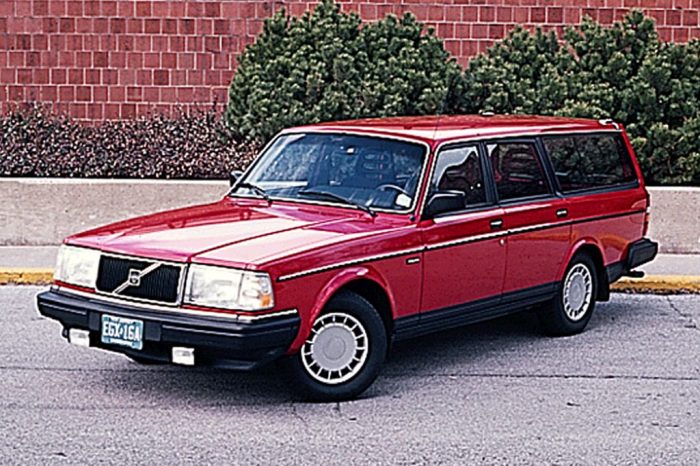
The 1990 Volvo 240, renowned for its sturdy build and emphasis on passenger safety, has consistently been regarded as one of the safest cars of its era. Volvo’s dedication to safety engineering was evident in the 240’s design, which incorporated innovative features that were ahead of their time.
Beyond its safety prowess, the 240 gained a reputation for its remarkable reliability and durability, attributes that have contributed to its enduring popularity among enthusiasts and collectors.
Safety Features
The 1990 Volvo 240 was equipped with a comprehensive suite of safety features, including:
- Three-point safety belts: The 240 was among the first cars to offer three-point safety belts for all passengers, a feature that has become standard in modern vehicles. These belts, designed to distribute impact forces across the chest and pelvis, significantly reduced the risk of serious injury in accidents.
- Anti-lock braking system (ABS): While not standard on all models, ABS was available as an option on the 1990 240. This system prevented the wheels from locking up during hard braking, enhancing vehicle control and reducing the risk of skidding.
- Reinforced passenger compartment: The 240’s passenger compartment was constructed with a rigid steel cage, designed to absorb and dissipate impact forces in a collision, protecting occupants from intrusion.
- Front and rear crumple zones: These zones were strategically designed to absorb impact energy, minimizing the force transferred to the passenger compartment.
Reliability and Durability
The 1990 Volvo 240 was renowned for its robust construction and reliable mechanical components. The car’s simple design and use of durable materials contributed to its long lifespan and reputation for reliability.
- Engine: The 240’s B230 series engines, known for their durability and efficiency, were often capable of exceeding 200,000 miles with minimal maintenance.
- Transmission: The 240’s manual and automatic transmissions were known for their robust construction and reliability, with many examples lasting well over 200,000 miles.
- Suspension: The 240’s suspension system was designed for durability and provided a comfortable ride. While requiring regular maintenance, it was known for its ability to withstand the rigors of everyday driving.
Real-world Experiences and User Reviews
The 1990 Volvo 240’s reputation for safety and reliability is supported by numerous real-world experiences and user reviews.
“I’ve owned my 1990 Volvo 240 for over 20 years, and it’s been incredibly reliable. I’ve never had any major mechanical issues, and it’s still going strong. It’s also been very safe, and I feel confident driving it with my family.”
John S., owner of a 1990 Volvo 240
“I was involved in a minor accident in my 1990 Volvo 240, and I was amazed at how well the car protected me. The impact was absorbed by the crumple zones, and I walked away without a scratch.”
The 1990 Volvo 240, a classic boxy sedan, epitomized Swedish engineering and safety. While its design might seem dated today, it was ahead of its time in its robust construction and reliable performance. By the mid-2000s, Volvo had moved towards a more modern aesthetic, exemplified by the 2007 Volvo C70 , a sleek convertible that showcased the brand’s evolving design language.
The 240, however, remains a testament to Volvo’s enduring legacy of building cars that are both practical and durable, even if they don’t always embrace the latest trends.
Sarah M., owner of a 1990 Volvo 240
These real-world experiences highlight the 1990 Volvo 240’s reputation for safety and reliability, underscoring its enduring legacy as a well-engineered and durable vehicle.
Legacy and Impact
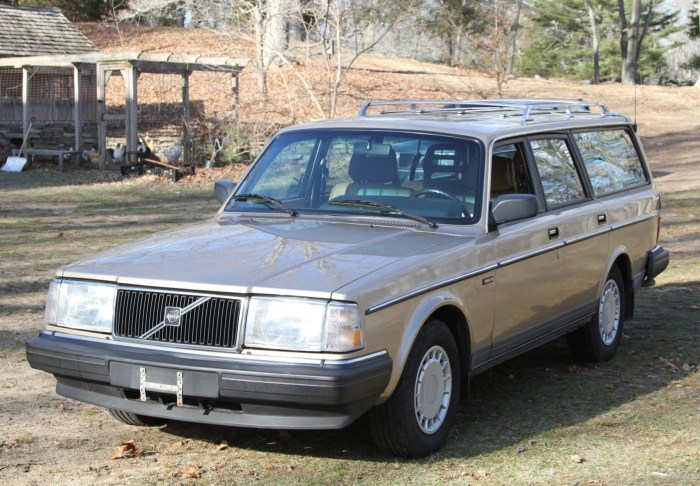
The 1990 Volvo 240, a car known for its rugged durability, safety features, and timeless design, left a lasting impact on the automotive industry. Its influence can be seen in subsequent Volvo models and even in the design philosophies of other carmakers.
Cultural Significance and Influence
The 1990 Volvo 240 transcended its role as a mere vehicle, becoming a cultural icon. Its boxy design, sturdy build, and reputation for safety resonated with a wide audience, attracting a loyal following of enthusiasts who appreciated its practicality and reliability.
The car’s enduring popularity is evident in its continued presence on roads worldwide, even decades after its production ceased. The 1990 Volvo 240’s influence on subsequent Volvo models is undeniable. The company’s commitment to safety, which was deeply ingrained in the 240’s design, became a cornerstone of Volvo’s brand identity.
The 240’s ruggedness and practicality also paved the way for the development of Volvo’s successful line of station wagons, which continue to be popular today.
Owner Experiences and Anecdotes
The 1990 Volvo 240 has left an indelible mark on the hearts and minds of its owners. Many enthusiasts share stories of their experiences with the car, highlighting its reliability, durability, and comfort.
“My 1990 Volvo 240 has been my faithful companion for over 20 years. It’s never let me down, and it’s always been there for me, rain or shine. It’s a true testament to Swedish engineering.”
John, a long-time Volvo 240 owner.
“I bought my 1990 Volvo 240 used, and it was the best decision I ever made. It’s a tank on wheels, and it’s incredibly comfortable. I’ve taken it on countless road trips, and it’s always performed flawlessly.”
Sarah, a Volvo 240 enthusiast.
The 1990 Volvo 240, a classic example of Swedish engineering, continued the legacy of its predecessors with its robust build and dependable performance. While sharing many similarities with its earlier iterations, the 1990 model benefited from refinements like a redesigned dashboard and improved safety features.
For those seeking a more modern take on the iconic design, the 1991 Volvo 240 introduced subtle updates like new grille designs and additional interior trim options. Despite these changes, the 1990 Volvo 240 remains a sought-after model for its timeless appeal and enduring reliability.
The 1990 Volvo 240’s legacy extends beyond its physical presence on the road. It has become a symbol of reliability, safety, and practicality, inspiring a generation of car enthusiasts and influencing the design and engineering of automobiles for years to come.
The 1990 Volvo 240 Today

The 1990 Volvo 240, a car that defined reliability and safety for a generation, continues to hold a special place in the hearts of enthusiasts and collectors. While no longer in production, the 240 remains a sought-after classic, commanding a loyal following and a growing market value.
Current Market Value and Collector Interest
The 1990 Volvo 240 has experienced a resurgence in popularity, with its value steadily increasing in recent years. This trend is driven by a combination of factors, including the car’s timeless design, its reputation for durability, and its growing status as a classic.
The price of a 1990 Volvo 240 can vary significantly depending on its condition, mileage, and specific model. A well-maintained, low-mileage example can fetch upwards of $10,000, while a more standard model might sell for around $5,000.
Challenges and Rewards of Owning a 1990 Volvo 240
Owning a classic 1990 Volvo 240 can be a rewarding experience, but it also presents certain challenges. The car’s age means that finding parts can be more difficult and expensive than for modern vehicles. The 240 also requires regular maintenance to keep it running smoothly.
However, these challenges are often outweighed by the joy of driving a classic car that is built to last.
“The 1990 Volvo 240 is a timeless classic that offers a unique driving experience. It’s a car that’s built to last and that’s sure to turn heads wherever you go.”
A 1990 Volvo 240 owner.
Comparison with Modern Cars
The 1990 Volvo 240, despite its age, remains a compelling choice for those seeking a classic driving experience. However, it is important to consider its limitations when compared to modern vehicles.
| Feature | 1990 Volvo 240 | Modern Car |
|---|---|---|
| Engine | 4-cylinder, 2.3L, 112 hp | 4-cylinder, 2.0L, 180 hp or higher |
| Transmission | 4-speed automatic or 5-speed manual | 6-speed automatic or 8-speed dual-clutch |
| Fuel Economy | 19 mpg city, 25 mpg highway | 25 mpg city, 35 mpg highway |
| Safety Features | Disc brakes, power steering, seat belts | Anti-lock brakes, electronic stability control, airbags, lane departure warning |
| Infotainment System | AM/FM radio, cassette player | Touchscreen display, Bluetooth connectivity, navigation system |
Visual Representation

The 1990 Volvo 240’s design is a testament to the brand’s commitment to safety and practicality. Its boxy shape, while not the most aerodynamic, offered maximum interior space and a strong, rigid structure. The design was both functional and timeless, with clean lines and simple details that have aged gracefully.
Exterior Design
The exterior of the 1990 Volvo 240 is characterized by its boxy shape, with a long hood, a high roofline, and a short rear overhang. The front grille is large and rectangular, flanked by rectangular headlights. The rear end features vertical taillights and a large rear window.
The overall design is simple and uncluttered, with a focus on functionality and safety.
- The front grille is dominated by the Volvo logo, a simple, elegant symbol that has become synonymous with the brand’s commitment to safety.
- The rectangular headlights, positioned on either side of the grille, provide excellent visibility at night.
- The boxy shape of the car, while not aerodynamically efficient, offers a large interior space and a rigid structure, enhancing passenger safety in the event of a collision.
- The high roofline provides ample headroom for passengers in the front and rear seats, while the short rear overhang contributes to the car’s practicality.
- The large rear window offers excellent visibility, enhancing safety and convenience.
Interior Design
The interior of the 1990 Volvo 240 is functional and durable, prioritizing comfort and practicality over flashy design. It features a simple dashboard layout with large, easy-to-read gauges. The seats are comfortable and supportive, providing excellent comfort for long journeys.
- The dashboard is simple and functional, with large, easy-to-read gauges for speed, tachometer, and fuel level. The layout is designed for driver-centricity, ensuring easy access to all controls.
- The seats are comfortable and supportive, offering ample legroom and headroom for both front and rear passengers. They are designed for long-distance driving, with generous padding and adjustable lumbar support.
- The interior is finished with durable materials, such as vinyl and fabric, that are designed to withstand wear and tear. This practicality is a hallmark of Volvo’s commitment to long-lasting vehicles.
- The large rear window provides excellent visibility for passengers, while the high roofline ensures ample headroom for all occupants.
Epilogue
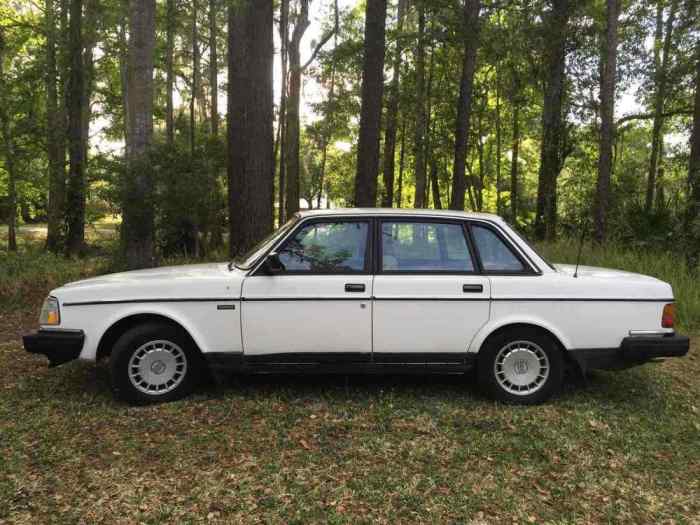
The 1990 Volvo 240 stands as a testament to an era when automotive engineering prioritized practicality and durability over flash and frills. Its lasting impact on the automotive landscape, particularly in terms of safety and reliability, continues to resonate with enthusiasts today.
Whether admired for its classic styling, its dependable performance, or its historical significance, the 1990 Volvo 240 remains a cherished icon of Swedish automotive prowess.
